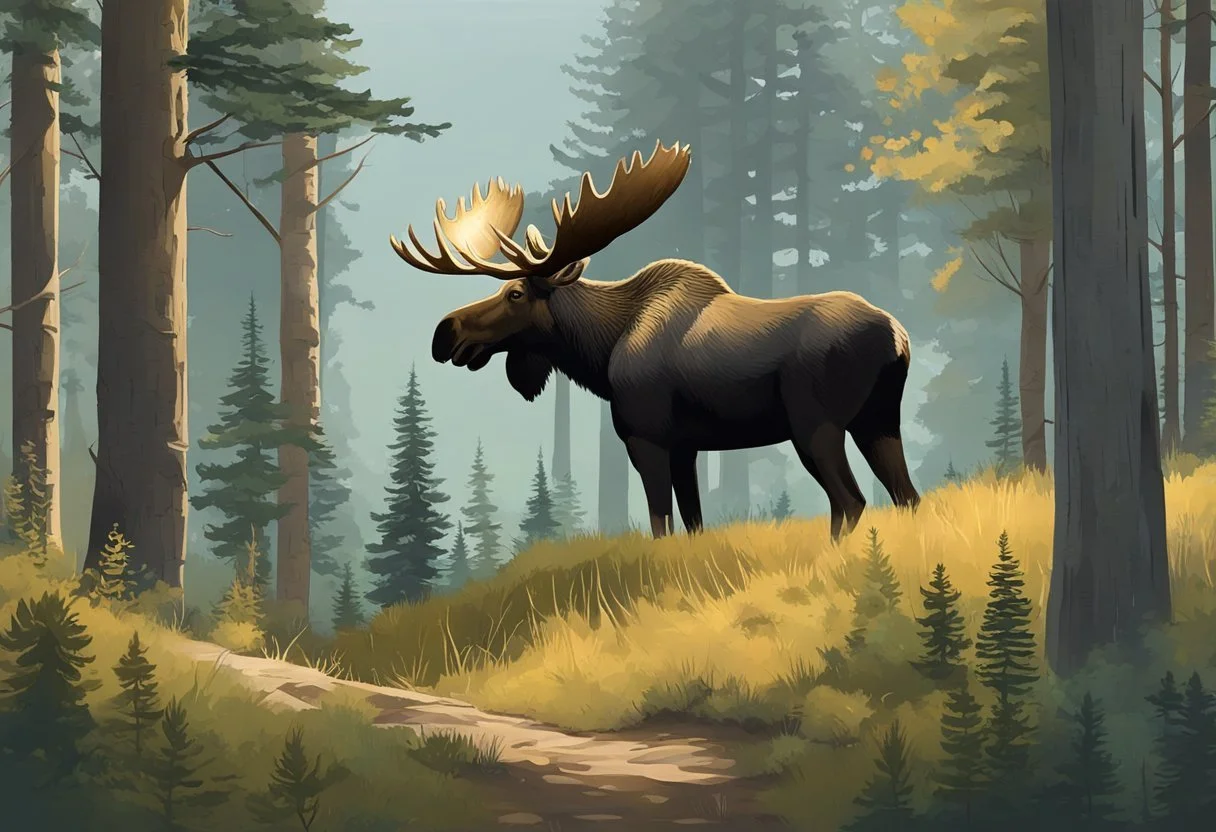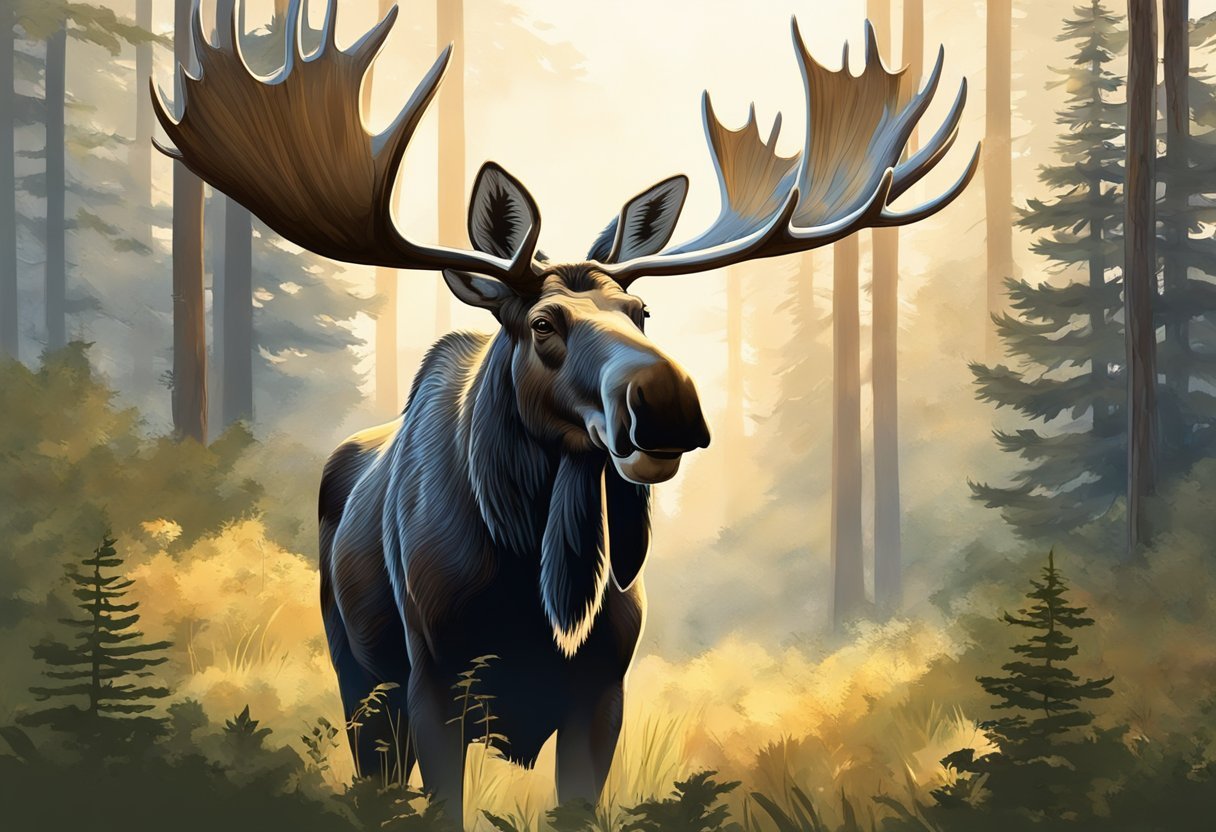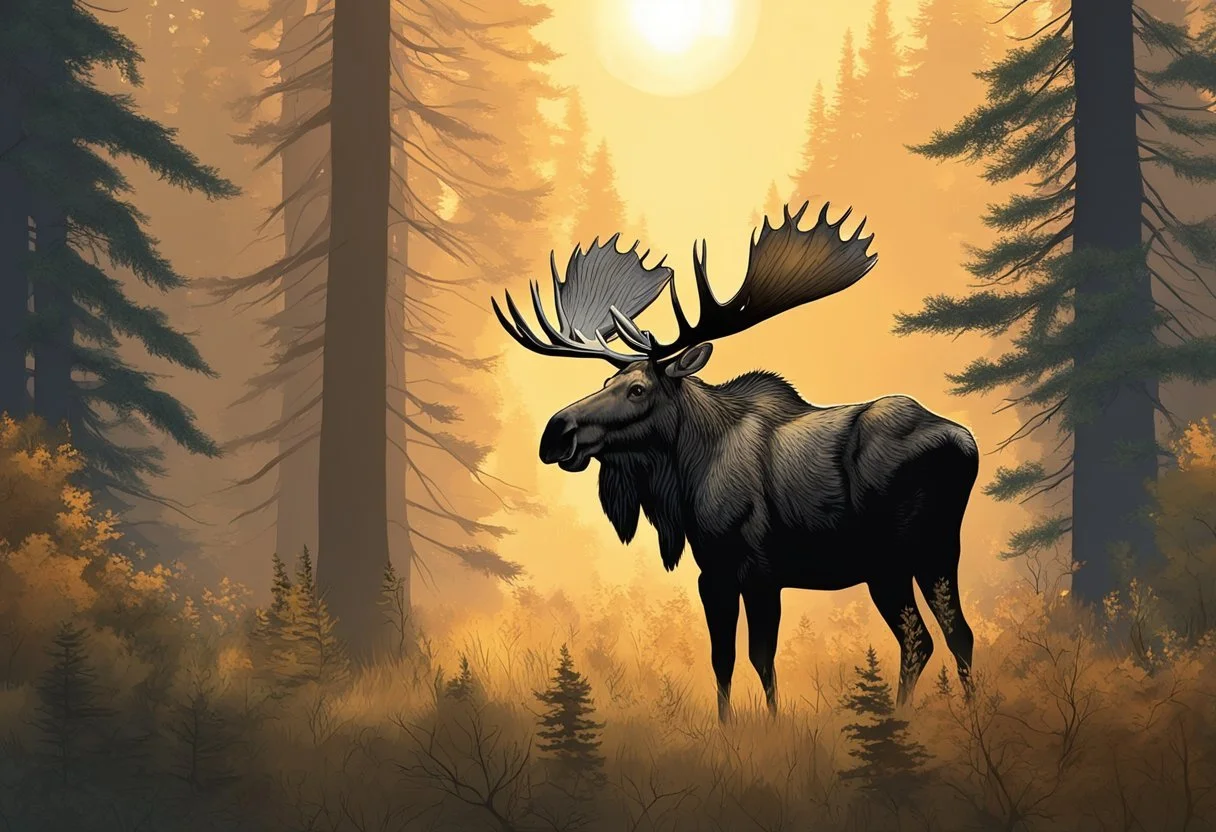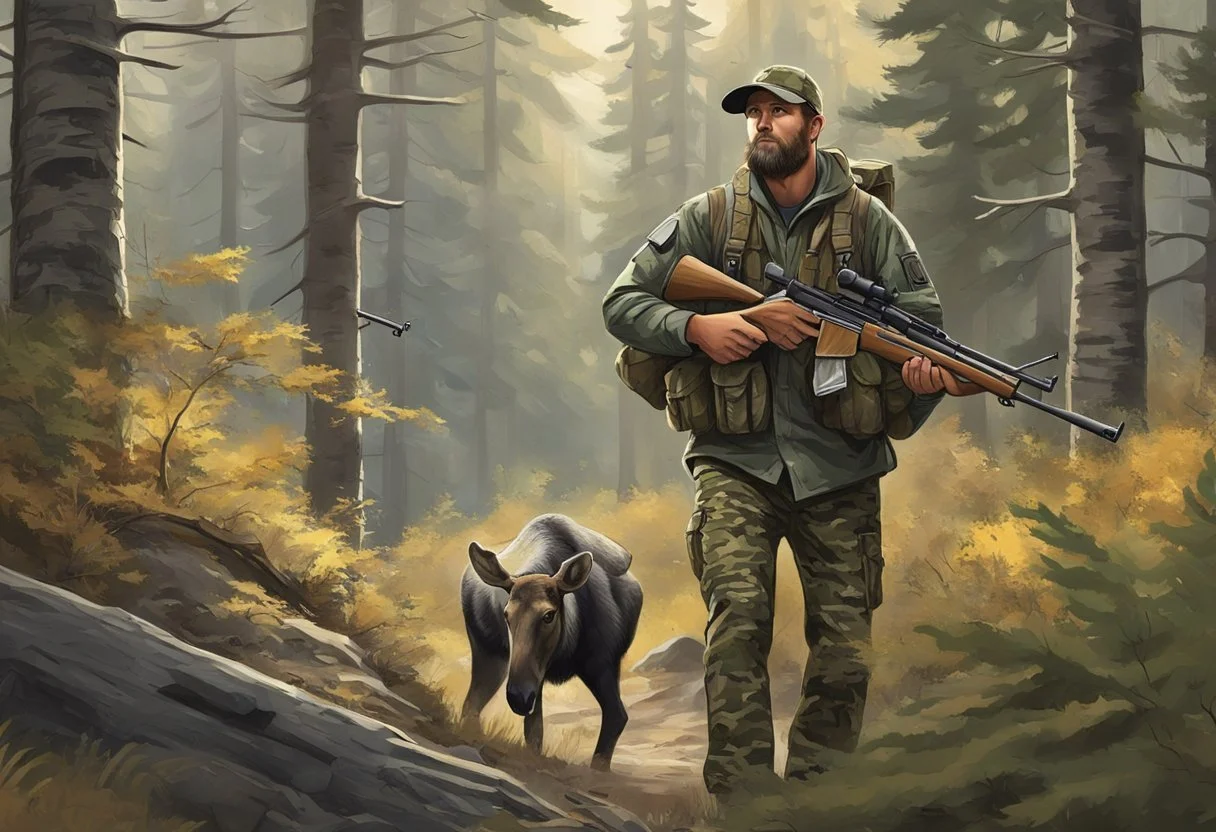Moose Hunting for Beginners
Essential Tips and Techniques
Discover > Hunting for Dummies > Moose Hunting for Beginners
Moose hunting is an exciting and challenging pursuit, drawing thousands of hunters into the wilderness each year. For beginners, embarking on this adventure is an opportunity to learn more about the natural world and improve their hunting skills. To prepare for a successful moose hunt, it is essential for newcomers to understand planning and to use safe methods to learn more about this majestic animal.
As a beginner, it's vital to become familiar with the biology and behavior of moose, which will aid in determining the best hunting strategies. Moose are known for their impressive size and strength, making it even more crucial for a novice hunter to approach the pursuit with caution and respect. Factors like habitat preference, mating habits, and seasonal patterns must be considered throughout the planning process.
Equally important, a beginner must research and understand the hunting regulations in their region, acquire the necessary permits, and consider hiring an experienced guide to ensure a safe and legal hunt.
Understanding Moose
Moose Species and Subspecies
There are four main subspecies of North American moose: the Eastern Moose, the Alaskan Moose, the Yukon Moose, and the Shiras Moose. Here is a brief description of each subspecies:
Eastern Moose: Found in eastern Canada and the northeastern United States.
Alaskan Moose: The largest subspecies, found in Alaska and parts of western Canada.
Yukon Moose: Commonly found in the Yukon and the western mountainous regions of Canada.
Shiras Moose: The smallest subspecies, found in the Rocky Mountain states and some parts of the Pacific Northwest.
Additionally the European moose lives in Norway, Sweden, Finland, Russia, the Baltic states, Belorussia, Poland and the northern part of Ukraine. The European moose is often more aggressive than the North American moose, and will become very agitated at the sight of a predator.
Physical Characteristics and Behaviors
North American mature bulls are known for their antlers, which are exclusive to male moose. Antlers grow annually and shed by late winter, following the mating season. They can be quite heavy, weighing up to 40 pounds with a wide antler spread. Moose have long legs and a humped back, helping them navigate forested areas and marshlands. Some of their main predators include bears and wolves.
Their behavior can vary depending on factors such as age, sex, and environment. However, moose are known to be solitary animals and can be aggressive when provoked. Keeping a safe distance and respecting their space while hunting is essential.
Habitats and Feeding Patterns
Moose inhabit forests, swamps, and meadows and can be found near water sources such as lakes, rivers, and streams. They are herbivores and have diverse eating habits depending on the season. Their diet consists of:
Aquatic vegetation during the summer months
Deciduous leaves and twigs in the fall
Coniferous trees and shrubs during winter
Their feeding patterns can be helpful for hunting since they are most likely close to water sources and specific vegetation during periods of the year.
Moose Populations and Conservation
Moose populations have declined in certain regions due to habitat loss, disease, and predation. Therefore, conservation plays a vital role in maintaining healthy populations. This includes responsible hunting, such as respecting hunting seasons and quotas set by local wildlife authorities. By being informed and responsible hunters, beginners can contribute to their sustainable conservation.
Preparation for Moose Hunting
Licensing and Regulations
Before planning a moose hunt, familiarize yourself with the regulations and obtain the necessary permits and hunting license. Each region will likely have specific rules:
Hunting season
Legal firearms or archery equipment
Bag limits
Ethical practices
Physical and Skill Preparation
A moose hunt can involve long hours of hiking through difficult terrain and habitat types. When you hunt moose it is crucial to:
Build physical stamina by regularly exercising and hiking
Develop shooting skills with your chosen firearm or archery equipment
Learn effective calls to attract the animal
Study moose behavior and preferred habitat. Be aware of the breeding season and behavior change.
Selecting Proper Gear and Clothing
Wearing the appropriate clothing and having the right gear is vital for a comfortable and effective moose hunt. Make the following choices:
Dress in layers for better temperature regulation
Choose waterproof, breathable, and insulated clothing
Opt for camouflage patterns that blend with your hunting environment
Hunting Methods and Techniques
There are several methods and strategies to consider when you hunt moose , such as:
Spot and stalk: Locate moose from a distance, then stealthily approach for a shot
Calling: Mimic cow moose and bull moose vocalizations to lure them into shooting range
Still-hunting: Slowly move through moose territory, pausing frequently to scan for animals
Regardless of the method chosen, always prioritize safety and ethical practices in the field.
Moose Hunting Techniques
Using Moose Calls and Decoys
Moose calling is an essential skill for attracting these elusive animals. There are several types of calls, such as the cow call, bull call, and the challenge call. Moose hunters should be familiar with these various calls to improve your chances of success. While using calls, it's important to ensure the wind is in an advantageous direction, avoiding blowing your scent towards the moose.
Moose decoys can also be used to entice the curious nature of a moose. Place the decoy in an open area with adequate cover for yourself nearby. Using calls, you can attract the moose towards your decoy, thereby putting the animal in a better position for the hunter.
Cow Calls: Mimic the sound of a female moose to attract bulls.
Bull Calls: Mimic the sound of a male moose to challenge and lure other bulls.
Challenge Calls: Evoke aggression or curiosity in bulls during the rutting season.
Stalking and Spot-and-Stalk Hunting
Stalking involves moving slowly and quietly in an attempt to approach moose without scaring them away. Cover and camouflage are essential for effective stalking, and it is always advised to move against the wind to prevent detection.
Spot-and-stalk hunting combines the skills of scouting and stalking. This technique entails locating a moose, either through visual observation or signs of their presence (such as tracks and droppings), and then approaching the animal carefully while staying concealed.
Camouflage: Blending with your surroundings using good camouflage gear is crucial.
Cover: Moose hunters should utilize the natural environment, such as vegetation and terrain, to hide your presence.
Understanding Weather and Terrain
Weather plays a significant role in successfully hunting moose. Moose tend to become more active in cooler weather, seeking relief from the heat in dense vegetation or water sources. Rain can make stalking easier, as the wet terrain absorbs noise. However, it can also make tracking more difficult due to washed-away signs of the moose's presence.
Wind direction significantly impacts a moose's ability to detect your scent. When hunting, stay downwind of the moose or adjust your position to ensure the wind does not betray your presence.
Terrain also influences moose behavior. Look for areas with plenty of cover, water sources, and food availability, such as lowland marshes or mixed forested areas.
Navigation and Tracking
Reading Maps and Using GPS
Before heading out on moose hunts, it's crucial to familiarize yourself with the area's topography by studying maps. Pay attention to the rivers, valleys, and other water sources, as moose tend to frequent these areas.
Make sure to always carry a detailed map of the area and a reliable GPS device. GPS devices are not only valuable for pinpointing your location, but also for marking key waypoints, such as trails, potential hunting spots, and other useful points of interest.
Identifying Moose Signs
To increase your chances of success on moose hunts, identify telltale signs of moose activity. Common indicators include:
Tracks: Moose tracks are large, splayed hoof prints, with a distinctive shape that sets them apart from other ungulates.
Droppings: Moose droppings are round and about an inch in diameter. They typically appear in clusters or piles.
Browsing signs: Look for branches and vegetation stripped of leaves at a height of about 6 to 8 feet, which is within the moose's reach.
Keep in mind that patience is key when scouting on moose hunts. Signs of recent activity don't always guarantee a sighting, but persistence and attentiveness will eventually lead you to success.
Field Techniques for Tracking
Here are some effective field techniques for tracking moose:
Follow the tracks: If you stumble upon fresh tracks, carefully follow them, ensuring you don't make too much noise or disturb the environment.
Mind the wind: Moose have a keen sense of smell, so always be conscious of the wind direction to avoid alerting the animal of your presence.
Frequent scouting: Regularly visit different areas within your hunting grounds to learn the patterns and movements of the local moose population.
The more time you spend observing, understanding, and tuning into their behavior when you hunt moose the more likely you are to have a successful hunt.
During the Hunt
Setting Up for Success
To increase your chances of successfully hunting moose, ensure you are well-prepared with the right equipment and knowledge. Essential gear includes proper camouflage, a suitable weapon, binoculars, cow calls for calling moose and bull grunts for calling bull moose , and a comfortable backpack.
Here are some factors to consider when planning your hunt:
Location: Look for hunting opportunities in moose country with high populations, like Alaska. Consult the Alaska Department of Fish and Game for guidance on specific hunting areas and possibly for guided moose hunts if you're a beginner.
Time of day: Generally, moose are more active during the early morning and late afternoon hours. However, always check local regulations before hunting at night.
Weather conditions: Moose have a keen sense of smell, so pay attention to the wind direction to prevent detection.
Tactics for Approaching Moose
Once you find a suitable hunting area, utilize these techniques to approach your target:
Spot-and-stalk: Scan open areas using your binoculars, and when you spot a bull moose, move towards it slowly and carefully while staying concealed.
Cow Calls: Using cow calls and bull moose bull grunts can help lure moose into more open areas, making them easier to approach and providing clearer shots.
Be quiet: Move slowly and deliberately, avoiding rustling leaves, breaking branches, or making loud sounds that could alert your quarry to your presence.
Maintaining Safety and Awareness
Safety should always be a top priority during any hunt. Follow these safety guidelines:
Learn and obey all local hunting regulations provided by authorities like the Alaska Department of Fish and Game.
Practice gun safety by handling your weapon responsibly and never pointing it at another person. Check that the safety is engaged when not in use.
Maintain a heightened sense of awareness at all times. Be attentive to your surroundings and signs of moose activity, like tracks, droppings, or a telltale sign—an area where a moose has recently bedded down.
Buddy system: Hunting with a partner can be helpful for safety and support. Make sure you both agree on the essentials, like communication and hunting tactics.
After the Successful Hunt
Field Dressing and Trophy Preparation
After a successful moose hunt, proper field dressing is essential to preserving the quality of the meat and preparing the trophy. Start by positioning the moose on its back and making a shallow incision from the sternum to the anus. Be careful not to puncture the intestines. Tie off the anus and esophagus to prevent contamination when you remove the entrails
For trophy preparation of a bull moose, carefully separate the cape from the body by cutting along the shoulder line and around the neck. Remove the bull moose antlers with a saw or heavy-duty bone shears, and transport the skull.
Transporting the Moose Meat and Trophy
When packing out a moose, efficient use of space and proper care of the meat are vital. Separate the meat into manageable sections such as hindquarters, front shoulders, and backstraps. Cool the meat as quickly as possible by hanging it in a shaded area or using game bags.
Organize your hunting gear and evaluate your pack's capacity to accommodate the weight.
Ethical Hunting and Responsibility
Being an ethical hunter goes beyond following laws and regulations; it encompasses proper game management, conservation, and respect for the environment. As a moose hunter, you should:
Practice fair chase: Respect the animal by not using technology or tactics that provide an unfair advantage.
Minimize waste: Make every effort to utilize as much meat and other usable parts (e.g., hides, antlers) as possible.
Dispose responsibly: When packing out, leave the area clean by properly disposing of entrails and other waste materials.
Additional Outdoor Skills
Camping and Survival Skills
Developing essential camping and survival skills is crucial for a successful moose hunting experience. Start by familiarizing yourself with the essential gear you'll need:
Tent or bivouac: Choose a lightweight, sturdy option for easy transport and setup.
Sleeping bag: Make sure it's appropriate for the weather conditions in your hunting area.
Portable stove and fuel: You'll need this for cooking meals.
First aid kit: Accidents happen, so be prepared.
Navigation tools: Bring a map and compass, or a GPS device with extra batteries.
As a beginner, it's essential to have knowledge of the local stream and trails to access the best hunting spots. Practice basic outdoor skills such as:
Building a fire
Finding and purifying water
Reading a map or navigating with a GPS
Identifying signs of weather changes
Consider enrolling in a wilderness survival course, as it can help build your confidence and knowledge about outdoor survival.
Conclusion
In conclusion, moose hunting can be a challenging yet rewarding experience for beginners in the fall hunting season. To ensure a successful hunt, it is crucial to follow safety guidelines and adhere to the hunting regulations of the region, such as the 20a area. Developing a strong foundation in hunting knowledge and techniques is also essential for a more enjoyable and fulfilling experience.
Moose hunters should remember that continual learning is a vital aspect of this sport. They can benefit from:
Reading up on moose behavior and habitat
Participating in workshops or online forums
Practicing shooting techniques regularly
Listening to advice from experienced hunters
Moreover, sharing experiences with fellow hunters can be valuable for personal growth as a hunter, as well as fostering a sense of community. By exchanging tips and stories, hunters can learn from each other's successes and mistakes.







